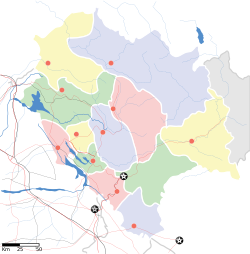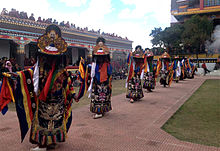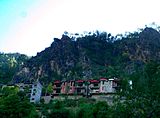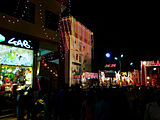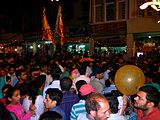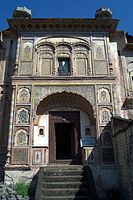Solan
|
|
This article has multiple issues. Please help improve it or discuss these issues on the talk page. (Learn how and when to remove these template messages)
(Learn how and when to remove this template message)
|
| Solan सोलन |
|
|---|---|
| Major City | |

From top, left to right: Thodo dance of Solan; Shoolini Utsav; Shoolini Devi Temple Solan; Yung Drung Monastery, Dholanji, Solan; panoramic view of Solan city
|
|
| Nickname(s): Mushroom city of India | |
| Location in Himachal Pradesh | |
| Coordinates: 30°54′18″N 77°05′49″E / 30.905°N 77.097°ECoordinates: 30°54′18″N 77°05′49″E / 30.905°N 77.097°E | |
| Country | |
| State | Himachal Pradesh |
| District | Solan |
| Government | |
| • MLA | Dhani Ram Shandil |
| Elevation | 1,502 m (4,928 ft) |
| Population | |
| • Total | 39,256 |
| • Rank | 2 in HP |
| Languages | |
| • Official | English |
| • Regional | Pahari, Hindi |
| Time zone | IST (UTC+5:30) |
| PIN | 173212 |
| Telephone code | 01792 |
| Vehicle registration | HP 14, HP 01S, HP 02S, HP 64, HP 59 |
| Avg. annual temperature | 18 °C (64 °F) |
| Avg. summer temperature | 32 °C (90 °F) |
| Avg. winter temperature | −2 °C (28 °F) |
| Website | hpsolan |
Solan is the district headquarters of Solan district (created on 1 September 1972) in the Indian state of Himachal Pradesh. The largest Municipal Council of Himachal Pradesh, it is located 46 kilometres (29 mi) south of the state capital, Shimla. At an average elevation of 1,600 metres (5,200 ft).[1] The place is named after the Hindu goddess Shoolini devi. Every year in the month of June, a fair celebrating the goddess is held, featuring a 3-day mela at the central Thodo grounds. Solan was the capital of the erstwhile princely state, Bhagat.[2]
It is known as the "Mushroom city of India" because of the vast mushroom farming in the area as well as the Directorate of Mushroom Research (DMR) situated at Chambaghat.
For the information of the readers the first research project on growing of edible mushrooms in India was sanctioned by the Agriculture Department, Govt of HP around 1959. This was entrusted to Shri S.S.Jain ( Late Shri Sukhbir Singh Jain) the first Mycologist and Plant Pathologist of the HP state. He came down from Shimla to Solan in 1959 and established the Mycology and Plant Pathology Laboratory single-handedly. With just one peon he started his experiments and was successful in growing the first button mushroom in India. Later as Officer on Special Duty he established the HP Agriculture University in a building on a hill close to the Solan Railway Station.
Solan is crowned as the "City of Red Gold", in reference to the bulk production of tomatoes in the area.[1] The town is situated between Chandigarh (joint capital of Punjab and Harayana) and Shimla (state capital), on the Kalka-Shimla National Highway-22. The Kalka-Shimla narrow gauge heritage railway line, built by the British passes through Solan and is a recognised World Heritage site.
Contents
- 1 Historical evolution
- 2 Heritage
- 3 Traditional clothing, dance
- 4 Food
- 5 Geography
- 6 Vegetation
- 7 Fauna
- 8 Climate
- 9 Demographics
- 10 Nagar Nigam
- 11 City area
- 12 Entertainment
- 13 Playgrounds and parks
- 14 Cinemas
- 15 Motilal Nehru Central State Library
- 16 Accessibility
- 17 Transport
- 18 Traffic and transportation
- 19 HRTC Solan
- 20 ISBT Solan
- 21 Railway
- 22 By air
- 23 Economy
- 24 Industry
- 25 Education
- 26 Private Medical College
- 27 Homoeopathic College
- 28 Private Engineering colleges
- 29 Solid waste management
- 30 Gallery
- 31 References
- 32 External links
Historical evolution[edit]
The history of Solan goes back to the era of Pandavas. According to local folklore, Pandavas lived here during their exile.[3] In 1815 British won Baghal state (now Solan) from the Gurkhas, Gurkha fort or Arki Fort is still standing tall on a mountain near to Solan city and it is one of the popular historic tourist attractions of Solan.[4] The town has been a capital of the princely Baghat State. The word Baghat is derived from Bau or Bahu, meaning "many", and Ghat meaning "pass". Initially the state headquarters of the Baghat State was located at Bhoch in the Bhuchali pargana, but the headquarters of the state was shifted to Solan after the construction of cantonment over here. The railway was set up in 1902.[5] The evolution of Solan city can be understood in the following order or sequence :-
- Establishment of a cantonment area at Solan by Britishers.
- Establishing Solan brewery in 1855 due to availability of excellent quality mineral water.
- Shifting of the headquarters of Baghat State from Bhoch to Solan.
- Start of Kalka-Shimla rail line in 1902.
- Start transportation activity on Kalka-Solan-Shimla road.
- The urban local body i.e. Municipal Council Solan came into existence in 1950.
- Solan became an independent district on 1 September 1972, and the town of Solan became the district headquarters.[5]
Heritage[edit]
Solan can be called a British town as primarily a cantonment was built here in the late 19th century by the British.[6] Solan cantonment is still the best and the most well planned part of this area hence buildings are made in a planned manner. The church in Solan cantonment is a heritage building with beautiful wooden and stone carvings, it has elegant sloping roofs plus arches reminiscent of the British architecture.
The list of heritage buildings in solan town is as below :-
- Shoolini devi temple.
- The Church in Solan cantonment.
- The Solan railway station, one of the Highest railway stations in the world.[7]
- The Barog railway station.
- Hari Mandir a famous Lord Krishna temple.
- The railway station and the railway rest house at Salogra.
- The DC residence on Shilly road.
- Anees villa, ancestral home of Salman Rushdie Shilly road near DC residence.[8][9]
- S.E., PWD office which used to be a durbar hall of Baghat State.
- Old guest house in the palace of Baghat state.
- Khalifa lodge (now the JBT college running in it).
- Nanak villa on tank road.
- Colonel Chopra's building near Thodo ground.
- Kishan Niwas and Hill View on circular road.[9]
- St. Luke's Sen Sec School, Solan the school built in hill architecture.
- Jatoli Temple (5 km. far from Solan on Rajgarh Road).
- Mohan Shakti National Heritage Park (in Hart, 12 km from Solan)
- Dolanji Bon Monastery, Solan.
- The Palace near Palace Road.
Traditional clothing, dance[edit]
Salwar suit is the main ethnic wear all over Solan Distt, other common dresses are also worn by ladies, where as men here have no specific traditional dress. Ghaghra suit is a traditional dress in Solan. However it is not much common and it can be seen only during cultural dances etc.
Where as in traditional ornaments ladies wear 9 Ladi Haar (a nine-strand necklace), Chaak (a golden ornament worn on head), gajru (heavy silver bracelets).
Pahari giddha or paruhan is the traditional dance of Solan district. This dance is originally from Kunihar, a small town is Solan district, which can be called as cultural town of Solan. This dance is performed by group of ladies on fast traditional songs.
A historical dance called Thodo dance here is also performed during shoolini mela every year in the month of June, the Thodo dance is basically a dance performed based on archery, bows and arrows are used in this dance.
Food[edit]
Himachali people are most hospitable, and inviting an ‘acquaintance’ (this could be someone they’ve just met!) home is a way of life. The host will then offer whatever food there is available in the house, here a general believe is that a guest should not leave without eating. Cuisines of Solan are spicy, so grab a glass of water before you start eating. The preferred food in Solan mainly consist of vegetarian food, with a generous dose of spices like cardamom, cinnamon, cloves and red chillies very much the norm. The average cuisine churns out all sorts of lentil and cereal preparations.
While the everyday meal is the usual dal-chawal-subzi-roti (the common north Indian meal of rice, lentil broth, dish of vegetables and bread),
special dishes are usually prepared on significant occasions. Some of the popular Traditional dishes are as below:-
- Poode, made from a batter of wheat, jaggery syrup (gud) which is then shallow fried in ghee or oil.
- Lushke, made from wheat, rice flour with little baking soda and is similar to a pancake.
- Patande, yet another popular dish of Solan, sirmour district of the state. Patande is made from wheat and is similar to a pancake as well.
- Sidu, a kind of bread made from wheat flour stuffed with dal and spices. It is kneaded with yeast and the dough is allowed to rise for 4–5 hours. With a stuffing of fat it is first browned over a slow fire and then steamed.Sidu is normally eaten with ghee(clarified butter)
- Askalu, made from wheat, rice flour with little baking soda, the batter is put into a special utensil made from stone called askali which contains several small molds in it.
- Pachole, a seasonal dish made from mashed sweet corns with spices, which is then steamed and eaten with ghee (clarified butter).
Geography[edit]
Solan city is located at 30°55′N 77°07′E / 30.92°N 77.12°E.[10][11] It has an average elevation of 1502 metres (5249.34 feet). The highest point is atop Mount Karol 2280 metres. Pandava's cave, where Pandavas believed to have meditated, is located at the mountain top. Solan gets snowfall during winters.[12]
Solan is a base station for the nearby tourist destinations including Chail, Dagshai, Subathu, Kandaghat and Churdhar peak.
Vegetation[edit]
Solan Planning area contains Chil, Deodar, Ban and Kail, mainly deodar and pine trees in the city . Oak forests are also at higher elevations around moist locations.places like chil is the most predominant one for different species of vegetation. Besides this natural or indigenous vegetation there is ornamental and alien plantation too. It consists of silver oak, jhakranda, bottle brush, weeping willows, kachnar, grasses etc.[12]
Fauna[edit]
Due to variations in altitude, there is a variety of fauna in the region. The himalayan black beer & panther are the carnivora whereas the Ghoral and the barking deer are the herbivora in and around the Solan Planning Area. Other animals include the jackal, mongoose, the Jangli billi, monkeys & langurs etc. The game birds include jungli murga, kabutar, ghughi, dhaula teetar and kolsa etc.[13]
Climate[edit]
Situated at an altitude of 1600 metres on an average, Solan can be called as a cool Hill station. Solan city is neither so cold as Shimla, nor too hot as Kalka as the temperature hardly rise more than 32 °C (90 °F). That is why it is considered as an ideal station from residential point of view. During winters Solan experience little snowfall. Temperatures typically range from −4 °C (25 °F) to 32 °C (90 °F) over the course of a year, with record high temperature of 37 °C.
| Climate data for Solan | |||||||||||||
|---|---|---|---|---|---|---|---|---|---|---|---|---|---|
| Month | Jan | Feb | Mar | Apr | May | Jun | Jul | Aug | Sep | Oct | Nov | Dec | Year |
| Average high °C (°F) | 13.2 (55.8) |
15.3 (59.5) |
19.8 (67.6) |
25.1 (77.2) |
29.3 (84.7) |
29.5 (85.1) |
25.2 (77.4) |
24.2 (75.6) |
24.5 (76.1) |
22.9 (73.2) |
19.6 (67.3) |
15.8 (60.4) |
22.03 (71.66) |
| Average low °C (°F) | 4.1 (39.4) |
5.7 (42.3) |
9.6 (49.3) |
14.2 (57.6) |
18.4 (65.1) |
20 (68) |
19 (66) |
18.6 (65.5) |
17.2 (63) |
13.3 (55.9) |
8.9 (48) |
5.8 (42.4) |
12.9 (55.21) |
| Average precipitation mm (inches) | 87 (3.43) |
67 (2.64) |
73 (2.87) |
27 (1.06) |
40 (1.57) |
120 (4.72) |
393 (15.47) |
325 (12.8) |
186 (7.32) |
52 (2.05) |
12 (0.47) |
29 (1.14) |
1,411 (55.54) |
| Source: climate-data.org[16] | |||||||||||||
Demographics[edit]
According to the 2011 Indian census, Solan city planning area has a population of 39,256.[17] making it the second largest city of Himachal after Shimla. Solan had an average literacy rate of 85.02.[18]
Nagar Nigam[edit]
M.C, Solan is spread over an area of 33.43 km2 with a residential population of 39,256.[17] It is the largest Municipal Council of Himachal, but now it is being upgraded to Municipal Corporation which will be third in Himachal after Shimla and Dharamshala M Corp.[19]
City area[edit]
Solan Planning Area covers 3343.00 hactares = 33.43 km2 hectares of land(Largest city area in himachal Pradesh).[20]
SAKSHAM SUCCESS ENTERPRISES the mall solan
Entertainment[edit]
For children there are three parks in the city:-
- Children park The Mall Solan, famous for its animals statue rides and musical fountain.
- Jawahar park, on the top hill in the heart of the city, famous for its rose gardens.
- Mohan park, Chambaghat road Solan. known for its paintings and lord shiv statue with fountains.
whereas for other age groups there are many sources of entertainment like Anand cinema, where you can enjoy latest releases every week. For pool and snooker lovers there are many points where they can enjoy the game. The youth have coined a term " Malling " which means to hang out on the main Mall road area with friends/family, window shopping, or have some authentic Chinese cuisine at " Friends Corner " . The Rohit Chinese Stall in Kotla Nala serves mouth watering authentic Chinese cuisine . The Sunder Ayan Cinema renovated and re-opened in 2015 is the best place to watch movies. The booking can be made on bookmyshow.[21] More over the Solan Mall road is the best place for youth to hang out, there are over 20,000 college students in Solan studying in various universities .
Playgrounds and parks[edit]
The town has three parks. These are
- Jawahar Park - Located at the highest point of the town proper, it has fountains, rides, baby train, small play field etc.
- Children Park - Located on the Mall road itself near DC Office, it has animal rides, rides, musical fountain & a cafe etc.
- Mohan Park - Built by Mohan Meakins breweries near Chambaghat on the Mall road, it has a beautiful terrace garden, rides etc.
- Subhash Chandra Bose Park - Hospital road solan.[22]
There are following grounds in the town :-
- Thodo ground - Near MC Office, it is the centre of all cultural, official & sports activities.
- Police ground - Adjoining Police lines at Kather it is an upcoming ground & has the potential of making of a stadium. VIPs' helicopters land on this ground.
- Radhaswami Satsang - A large ground at Anji.
- An indoor stadium is under construction with a cost of rupees 6 crores.
The town has a number of community halls. Some hotels nearby also have excellent facilities for arranging marriages, functions, meetings or parties. There are religious institutions too offering such facilities. MC Solan has its own community hall near Thodo ground.[22]
Cinemas[edit]
Solan city has the distinction of having the best cinema in State as on today. There is cinema house namely Sunder Cinema reopened as the first Multiplex cinema in Solan.
Motilal Nehru Central State Library[edit]
Motilal Nehru Central state library is situated on The Mall, Solan. Established on 29 June 1959, it is the only Central State Library in Himachal Pradesh. All the schools and public libraries in the state come under it. Till 1973 the library was running a certificate course in library science, and had even initiated the Mobile Library project to benefit youth in rural areas of the state.
This library is Responsible for managing all school & public libraries in the state. There are thousands of precious and valuable books housed in this library.This library located near of PNB bank.
Accessibility[edit]
The National Highway No. 22 is a prominent road passing through Solan town. It is an important road from many points of view. Firstly it is a defence road connecting Delhi, Dehradun, Ambala and Chandigarh to the China Border. Next it is the life line of our State as all raw products, building materials, passengers, goods etc. come through this route only. Our own products go out via it. It is on account of its significance that there are today 2 bypasses within Solan Planning Area. These are :
- Solan bypass linking Saproon and Chambaghat.
- Barog bypass linking Saproon and Kumarhatti via Anji & Raboun. The Centre Government is also likely to undertake the 4-laning of this road. Surveys and studies have been completed in this regard.
Besides N.H.-22, we have many other important roads connecting Solan to its nearby areas, towns or settlements. These are: -
- Solan - Rajgarh road.
- Solan - Subathu - Arki Road.
- Solan - Kandaghat road via Basal and Salumana.
- Solan - Jaunaji road.
- Solan - Damrog - Jatoli road.
- Solan - Ashwani Khad road. It will ultimately connect Solan to Herth as well as Chail.
Transport[edit]
Solan is accessible by road as well as train. It is 68 kilometers from Chandigarh (2 hours journey by bus) and 48 kilometers from Shimla (1 hours journey by bus). There are a total of 44 railway tunnels up to Solan.
Traffic and transportation[edit]
Traffic and transportation is the next most important aspect to be taken care of after water supply and sanitation. Solan town is said to be having highest level of vehicle ownership per person in Asia. It may be just right. Every week one can see a vehicle or two coming on the road - brand new with HP-14, HP-64 number series. Presently an area of 138 hectares is covered under this use.
[Apparently there is desperate need for parking in the mall road vicinity as the number of vehicles are growing rampantly.]
HRTC Solan[edit]
Himachal Road Transport Corporation Solan Depot came into existence in 1 November 1990 after shifting from Parwanoo. The depot is providing public transit facility to its passengers in the state of Himachal (rural and urban) and to the adjoining states and Union Territory like Chandigarh, Punjab, Haryana, Delhi Uttar Pradesh and Uttaranchal. Almost each and every part of Distt. Solan is linked with roads. The HRTC Solan is running its buses covering Solan, Sirmour, Bilaspur, Shimla, Hamirpur and Kangra districts of Himachal Pradesh. There is huge network of HRTC to cater the needs of the commuters. Journey to various stations of Himachal has become easier than ever because the huge network of HRTC buses. The HRTC Solan is running approximately 206 single routes, with the fleet of 83 buses and operating four types of buses:
- Ordinary buses
- High-Tech buses
- City Bus (Mudrika)
- Tata Air conditioned bus
Solan depot is pioneer in introducing Electronic Ticketing Machine, implementing Tally software & almost computerized for following work.
- Monthly Review Data & its Analysis
- Route-wise Information
- Vehicle-wise Information
- Payroll
- Inventory
- Daily Monitoring System
for more detail you may visit 'www.gurbachan.weebly.com
ISBT Solan[edit]
There are two bus stands presently functioning in Solan city. One is the New bus stand which is below ITI Solan on the by-pass road which also is the main bus stand of the city. The other is known as the Old bus stand which is situated on The Mall and is used as the local bus stand. Solan City also has a good inter city (Mudrika) three bus services that connects the local areas of Solan city.all the interstate buses towards Chandigarh, nahan pass through it
At Solan busstand free wi fi facility is available.
Railway[edit]
The Kalka-Shimla Railway was included in the UNESCO World Heritage List as part of the World Heritage Site Mountain railways of India on 7 July 2008.[23]
By air[edit]
The nearest airport is Shimla airport which is about 45 km from solan. The Himachal Pradesh government is setting up its first international airport at an investment of Rs.1,000 crore in Solan district of the state on a public private partnership model given the significance and pace of development that Solan has witnessed in recent times in the state of Himachal.
Economy[edit]
Solan is an industrial hub of Himachal Pradesh. Tourism also contributes to the economy of Solan. One the tehsil of Solan known by the name of Nalagarh is also known as the Pharma Hub after the introduction of Special Subsidies by the Prime Minister of India in the year 1999.
Solan is also developing as education hub of Himachal Pradesh with many established technical institutions as well.
Industry[edit]
Solan is a fairly Important Industrial town.[original research?] Xchanging Technology Limited which is an Information Technology Company is the only UK based MNC which exists in the Town and is the largest corporate employer in the region. It has close to 250 employees and are planning to grow further in years to come. UK based Insurance Business and software testing and development is carried out from this office at Solan. In May 2016 Xchanging Technologies was acquired by a US giant CSC (Computer Science Corporation) . With this they have become world number one Insurance support providers in the world .
Education[edit]
The city has many High schools of government and private bodies There are many schools from the British era. Some of the popular schools in the city are:
- B.L Central Public school
- Genius Global Playschool (Formerly known as Genius Eurokid Playschool)
- Chinmaya Public School
- Dayanand Adarsh Vidalya
- Doon Valley Public School Solan
- Govt. Boys school Tank Road Solan
- Govt. Girls School The Mall Solan
- Gurukul International School
- MRA DAV Sr Sec Public School Solan
- PNNM Geeta Adarsh Vidyalaya
- Punj villa School, Dhobighat Solan
- Sanatan Dharam school
- St. Luke's Sen Sec School, Solan
- Woods Stone School
Solan has many reputed boarding schools in which four are in the list of top boarding schools of India, they are:-
- Chail Military School
- Dagshai Public School
- The Lawrence School, Sanawar
- Pinegrove School
Central government[edit]
- Central Research Institute, Kasauli.
- Dr. Yashwant Singh Parmar University of Horticulture and Forestry, Nauni, Distt. Solan
State government[edit]
- Government Polytechnic College for Women
Private Dental Colleges[edit]
- Bhojia dental college and hospital, Budh (Baddi) Dist. Solan
- M.N.D.A.V. Dental College & Hospital, Solan
Private Medical College[edit]
- MM University & Medical College, Solan Distt. Solan
Homoeopathic College[edit]
- Solan Homoeopethic Medical College, Barog Bypass, Kumarhatti.
Private state universities[edit]
- Baddi University of Emerging Sciences and Technologies, Baddi, Distt.Solan
- Bahara University Solan
- Chitkara University, Barotiwala, Distt. Solan
- Jaypee University of Information Technology, Waknaghat, Distt. Solan
- Maharaja Agrasen University
- Manav Bharti University, Kumarhatti, Distt. Solan
- Shoolini University Solan
Private Engineering colleges[edit]
Tourism
As on today Solan itself is not an important tourist spot. However it is known as a reference station for tourists places nearby. Included in that category Chail, Kasauli, Dagshai, Subathu, Kandaghat, Churdhar peak etc. Many visitors destined for Shimla, Kinnour & other areas of the state use this town as a halting station. The tourist infrastructure as on today includes following hotels:-
- Hotel Paragon Palace
- Ambusha Resorts, The Mall.
- Pine Grove, Deonghat
- Mayur, The Mall
- Utsav, The Mall
- Yogesh, The Mall
- Himani Resorts, The Mall
- Konark, Chambaghat
- Parkson, Chambaghat
- Anand Hotel, the Mall
- Harsh Palace
- Flora Holiday Resorts
- Premjee's Paradise, The Mall
- New Chanakya Restaurant, The Mall.
- Surbhi
- Ashok
- Krishna
- Shingar
- Shere Punjab
- Thakur
- Kumar
- Sharma
- Anupama
- Ashray
- Green
- Kashyap
- Tip Top
Besides the Dr. Yashwant Singh Parmar University of Horticulture and Forestry at Nauni, other places of interest in Solan include the Shoolini Mata temple, the Jatoli Shiv temple and the Yungdrung Tibetan Monastery, near Nauni, it is in Dolanji approximately 3 km from oachghat oldest in India and second oldest in the world. The Central state liberary is also there, on the mall road which is the only central liberary in Himachal.
A tourist information office (cafe, restaurant) is opened at Solan. It may soon have a few tourist mini buses so that travels could be arranged to Dagshai, Kasauli, Subathu, Chail, Giripul etc.
The town of Kasauli is a popular hill-station holiday and honeymoon destination with the temple devoted to the Hindu god Shiva. It is also home to an Army and Air Force base.
One of the small towns developed by the British during the 'hey days' of the empire, reached by a branch road from the Kalka-Shimla road, has the beautiful hill-station of Kasauli where the Pasteur Institute produces the antirabies vaccine against mad dog-bite and, at the same time, treats victims who have fallen prey to the deadly disease, Hydrophobia. If the victim of a dog-bite is not treated in time - hydrophobia, or fear of water occurs, resulting in his inability to swallow water. For the dog set,[clarification needed] Louis Pasteur performed invaluable service when he perfected his vaccine in the late 19th century. The Central Research institute in Kasauli set up in 1900, is the oldest in India, taking care of police and army dogs as well as their masters. Nearby another institute produces other vaccines: the Central Research Institute works on immunity from Typhoid, smallpox [which has been eradicated], chlorea and snake-bite. This region has also been a witness to Gurkha expansion at now to ruins of old Gurkha Fort at Subathu. At 3647 mt, the Choordhar or Choor Chandni peak, looms over the sylvan surroundings, and just across the ranges, is Shimla. The upper and lower Malls are the two principal roads that run along the length of Kasauli, a thick cover of pine, oak, rhododendron, where horse chestnut trees embrace the entire area. Traffic is restricted on these roads, which is the reason why Kasauli is the quietest hill station in India. The resort's colonial aura is underlined by gabled houses with picturesque facades, cobbled alleys and rows of neat orchards and elegant gardens. The solan Hills stand on a water - parting between the Sutlej and the Giri, a tributary of the Yamuna. South of solan is the Panchmunda ridge which is crossed by a railway through a tunnel (the longest in the Kalka - Shimla run) at Barog, where a series of fissure to springs occur at its flank. the first ridge above Kalka rises abruptly to pineclad Kasauli at a height of 1927 meters and is joined by a 12 km bridle path. The distance by road, however, from Kalka is 36.5 km.
There is also a three-hundred-year-old Gurkha fort at Nauni, which dates back to the time when the region was ruled by the Gurkhas of Nepal. The fort is in ruins, but it is strategically located atop a mountain point providing a panoramic view of the entire area.
The proposed ropeway between Chambaghat and Karol is expected to contribute more to the tourism industry of the town.[24]
Also a national Heritage Park spreads over 40 acres of land at a cost of Rs 454 crore on the right bank of river Ashwani, where is the picturesque village Hurt near Solan. Elaborating on the concept of Heritage Park, Brig Kapil Mohan, chairman of Mohan Shakti Trust has undertaken the Heritage Park project, said that it would be a centre of learning and would generate sufficient inquisitiveness into the minds of people all over the world for Indian philosophy and ancient heritage. At the centre of the park, a grand temple is proposed where a magnificent collection of statues of gods and goddesses would be installed under the supervision of Kapil Mohan. Besides, an ancient Indian research centre is proposed for studying Indian Heritage and eminent scholars would be associated with it. the project consists of following salient features
- Big temples with exquisite architectural marvels.
- Meditation centre inside a cave.
- Theme park.
- Herbal Plantations.
- Fountains and landscaped gardens.
- Ropeway trolley.
- Research Centre.
- Ayurvedic healing.
- Yagyashala etc. etc.
Also, the park would have an auditorium facility provided with laser shows based on Indian mythology and epics of Mahabharata and Ramayana.
Solid waste management[edit]
MC Solan has a well organised network of solid waste collection & disposal. Waste is collected from 132 collection points with the help of 115 sanitation workers. Out of these 132 collection points, as many as 42 are the dumpers. The council has 2 placers and 1 tipper which is privately hired. It has 4 drivers. A total of 10 tons of solid waste is collected every day and transported to the waste recycling plant at Salogra. The plant is fully capable of meeting with the requirements of the town.
The waste recycling plant situated at Salogra is a unique thing in itself. Firstly it's only at Shimla and Solan that we have the waste recycling plants in Himachal Pradesh. Salogra plant has the distinction of being the first in HP It is till date being maintained by a non-government organisation (NGO) known by the name of "Jan Seva Ashram" which has its head office in New Delhi. The plant has land and processing plant capable of handling a total of up to 20 tons of solid waste. Presently on an average, up to 10 tons of waste arrives here. On festival days the quantum reaches up to 13 tons. As and when a dumper placer or a tipper arrives from a unit, the constituents are segregated by the workers into polythene, stone, medical waste, paper, kitchen waste & such categories. Paper is recycled in the paper recycling plant. The organic waste is kept in open heaps which decomposes in a period of 40–45 days reducing it to compost. The other part of the waste being sanitary in nature is dumped on open land. There are a number of facilities here. There is a JCB, a plant processor, soil testing & compost testing lab and an office.
Gallery[edit]
References[edit]
- ^ a b "Solan Travel and Tourism Guide".
- ^ Capital of Bhagat state
- ^ "Travel Is Our Passion: Trek To Karol Tibba, Pandava Cave". travelisourpassion.blogspot.in. Retrieved 2016-06-02.
- ^ "Gurkha Fort".
- ^ a b "Historical Evolution Solan City" (PDF).
- ^ "Solan City History".
- ^ "Solan Railway Station". indiarailinfo.com.
- ^ "anees villa".
- ^ a b "Heritage" (PDF).
- ^ Falling Rain Genomics, Inc - Solan
- ^ "Geographical setting" (PDF).
- ^ a b Report page:8
- ^ Report page:9
- ^ "Climate Data for Solan".
- ^ "Climate of Solan".
- ^ "Climate:Solan". climate-data.org. Retrieved 10 February 2014.
- ^ a b "Census of India 2011, Himachal Pradesh, Solan City census" (PDF).
- ^ "Solan Literacy Rate 2011".
- ^ "Solan set to be municipal corporation".
- ^ "Proposed land use of Solan Planning Area" (PDF).
- ^ "online booking". bookmyshow.
|first1=missing|last1=in Authors list (help) - ^ a b "Tourist Attractions in Solan".
- ^ "Kalka-Shimla Railway makes it to Unesco’s World Heritage list". The Hindu Business Line. 2008-07-09. Retrieved 2008-07-10.
- ^ TCP PDF: page7
External links[edit]
| Wikimedia Commons has media related to Solan. |
- Official Site
 Solan travel guide from Wikivoyage
Solan travel guide from Wikivoyage
